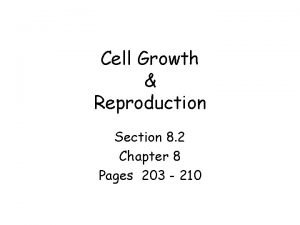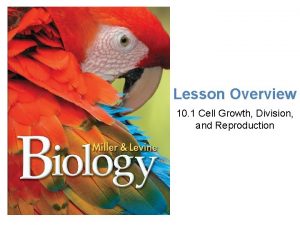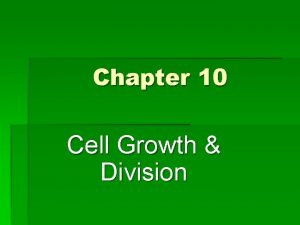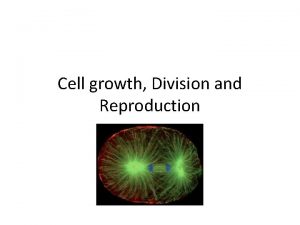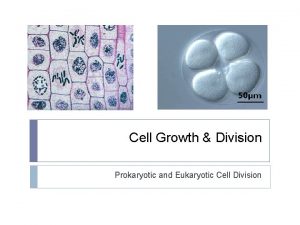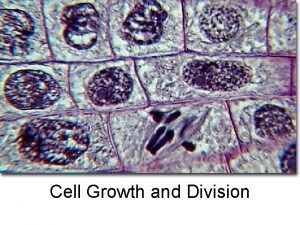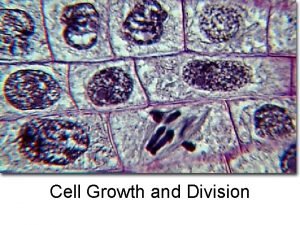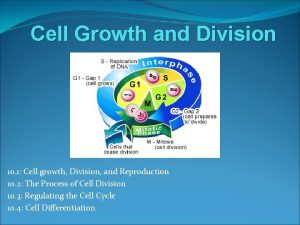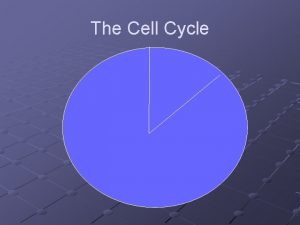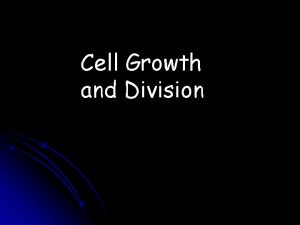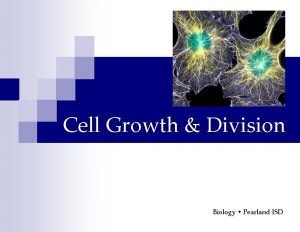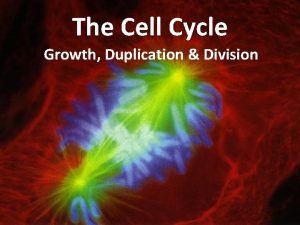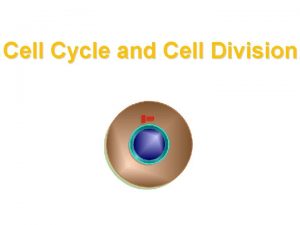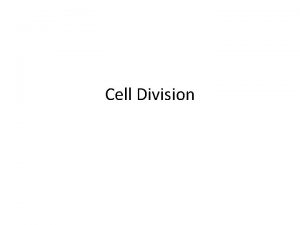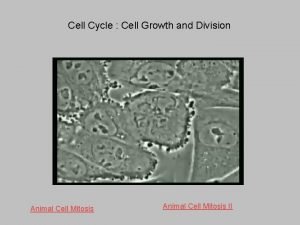The Cell Theory Cell Growth and Cell Division







































- Slides: 39

The Cell Theory, Cell Growth, and Cell Division http: //homepage. smc. edu/hgp/images/cell-to-DNA. jpeg

I. The Cell Theory: A. All living things are made of cells. B. Cells are the basic unit of life. C. All cells come from preexisting cells.

*** Characteristic of Life: Growth and Development

II. Cell Growth A. Is growth due to cells becoming larger and larger or is it due to more cells being produced? Answer: MORE CELLS

B. Human baby cells are no smaller than adult cells.

C. Limits of Cell Growth 1. Food and waste enter and exit through the cell membrane.

a. Speed of this movement is controlled by surface area to volume ratio. b. The greater the surface area to volume ratio (SA/V) the faster substances can move in and out. c. In general, the smaller the cell the bigger the SA/V d. SM. CELL= BIG SA/V= MORE EFFICIENT

Within which of these cells would nutrients get to the center fastest? http: //web. jjay. cuny. edu/~acarpi/NSC/13 -cells. htm

2. Another factor associated with cell growth is DNA and RNA. a. Larger cells use more proteins, which require more m. RNA. b. The cell only has a limited amount of m. RNA.

3. To solve these problems, the cell divides.

D. Rates of Cell growth (cell division). 1. Cells can divide at unbelievable rates, some every 30 minutes. 2. Rapid growth cannot usually continue for long.

E. Controls on Cell Growth 1. Some cells rarely divide such as heart and nerve cells. 2. Others such as skin and digestive cells divide frequently. 3. Normal cells sense when they are touching other cells.

4. Control of cell growth can be turned on and off. 5. Space, nutrients, light, etc… may also affect cell growth.

F. Uncontrolled Cell Growth: A major problem in multi-cellular organisms. 1. Cells that have lost their growth control are called cancer!! 2. They do not seem to sense when they come into contact with other cells and will grow until all nutrients are used.

Cancer 3. Cancer cells not only divide uncontrollably, they also divide in unusual ways. Inside Cancer

III. Cellular Division A. Mitosis and Cytokinesis 1. Mitosis: The first stage in cellular division. **Process in which the nucleus of the cell is divided into two nuclei, each with the same number and kinds of chromosomes as the parent cell.

2. Cytokinesis: process by which the cytoplasm divides, forming two distinct cells.

B. Why is cell division needed? 1. Growth (fertilized egg to adult) 2. Repair, replacement (wounds) a. Bone b. Skin, weeks c. RBC’s, 10 million/second 3. Does NOT occur in nerve and muscle cells (EX Heart cells).

C. Chromosomes 1. Meaning: “colored bodies”-only can be seen in mitosis. **not normally visible, but will pick up the color of dye. http: //w 3. uniroma 1. it/medicfisio/methnagenet. htm

2. Structures that contain the genetic info. (DNA) that is passed on from one generation to the next.

3. The cells of every organism contains a specific number of chromosomes. Ex. Human cells contain 46 chromosomes. 4. Composition: Made up of DNA and proteins. http: //www 2. geneticsolutions. com/Page. Req? id=3844: 1873

5. Structure of a Double Chromosome: a. Contains two single chromosomes. b. Centromere: Each pair of single chromosomes is attached at this area. (Usually located near the center of the chromosome. ) c. Each chromosome entering mitosis is actually a double chromosome. http: //anatomy. iupui. edu/courses/histo_D 502/D 502 f 04/lecture. f 04/cellf 04. html

D. The Cell Cycle: 1. 2. 3. 4. Growth Preparation for division Divides to form two daughter cells Daughter cells begin the cycle again.

Cell Cycle http: //www 2. geneticsolutions. com/Page. Req? id=3844: 1873

1. G 1 - 1 st period of growth for a cell during interphase. 2. G 0 – some cells will reach a point where they will no longer divide. **EX. Nerve cells—most of them Muscle cells (Ex. Heart cells)

3. S – DNA replication occurs in preparation for division. 4. G 2 – 2 nd period of growth *Replication of other organelles

5. M – Mitosis a. Prophase, Metaphase, Anaphase, Telophase b. The NUCLEUS divides. 6. C -Cytokinesis- division of the cytoplasm

E. Interphase: a. the chromosomes of the cell are tangled in the nucleus and look like string. b. Chromosome number doubles. c. Occurs BEFORE mitosis can occur.

F. MITOSIS (A closer look): • Normal nuclear division that produces 2 identical nuclei that are DIPLOID (a cell that contains a double set of chromosomes—one from each parent). http: //www. biology. iupui. edu/biocourses/N 100/2 k 4 ch 8 mitosisnotes. html

1. Prophase: • This stage shows the destruction of the nucleus. • Chromosomes become thick and darken. http: //www. dundee. ac. uk/biocentre/GRE%20 Scientific%20 images/pages/Prophase. htm

2. Metaphase: • chromosomes line up in the middle of the cell. http: //www. pc. vccs. edu/biology-labmanual/lab 7 mitmei/whitefishmeta. jpg

3. Anaphase: • The chromosomes begin to pull apart and the nucleus begins to separate. http: //content. answers. com/main/content/wp/en/thumb/3/38/300 px. Anaphase-flourescent. jpg

4. Telophase: • Two new nuclei form. http: //iknow. net/CDROMs/cell_cdrom/index. html

Mitosis and Cytokinesis http: //www. cbp. pitt. edu/faculty/yong_wan/index. html

IPMAT *This occurs in body cells, like skin, in order to repair wounds and in all other growing cells. *This does NOT occur in sex cells. P M A T

G. CYTOKINESIS: • As a result of telophase, the cell has 2 nuclei. • Thus, the cytoplasm must also divide. Cytokinesis results in two individual cells.

Plant Animation Animal Mitosis Cells alive The Cell Cycle The Stages of Mitosis

Can a Cell Divide Forever? • Normal Cells – NO – Telomeres, buffer zones at the tips of each chromosome, get shorter with each division – Cells die when telomeres are gone • EX: Aging effects are due to dead cells that can no longer be replaced

Can a Cell Divide Forever? • Cancer Cells – YES – Telomerase is ON • Enzyme that repairs telomeres after each division • Embryonic Stem Cells – YES - The Fountain of Youth lies in harnessing the anti-aging powers of telomerase without the risks associated with cancer. This is NO EASY TASK…
 Neoclassical growth theory vs. endogenous growth theory
Neoclassical growth theory vs. endogenous growth theory Chapter 8 cell growth and division section 8-2 answer key
Chapter 8 cell growth and division section 8-2 answer key Cell growth division and reproduction
Cell growth division and reproduction Events of the cell cycle
Events of the cell cycle Cell cycle and cell division
Cell cycle and cell division Steps of cell cycle
Steps of cell cycle Growth analysis
Growth analysis Eudicot
Eudicot Primary growth and secondary growth in plants
Primary growth and secondary growth in plants Primary growth and secondary growth in plants
Primary growth and secondary growth in plants Long division and short division
Long division and short division Long division and short division
Long division and short division Synthetic dicision
Synthetic dicision Synthetic division formula
Synthetic division formula Step growth polymerization vs chain growth
Step growth polymerization vs chain growth Geometric growth graph
Geometric growth graph Organic growth vs inorganic growth
Organic growth vs inorganic growth Chapter 4 cell theory and cell study
Chapter 4 cell theory and cell study Theory of growth and development
Theory of growth and development Cell division mitosis and meiosis
Cell division mitosis and meiosis Chromosome labeled
Chromosome labeled Mitosis
Mitosis Hát kết hợp bộ gõ cơ thể
Hát kết hợp bộ gõ cơ thể Frameset trong html5
Frameset trong html5 Bổ thể
Bổ thể Tỉ lệ cơ thể trẻ em
Tỉ lệ cơ thể trẻ em Gấu đi như thế nào
Gấu đi như thế nào Tư thế worm breton là gì
Tư thế worm breton là gì Chúa sống lại
Chúa sống lại Các môn thể thao bắt đầu bằng tiếng bóng
Các môn thể thao bắt đầu bằng tiếng bóng Thế nào là hệ số cao nhất
Thế nào là hệ số cao nhất Các châu lục và đại dương trên thế giới
Các châu lục và đại dương trên thế giới Công thức tiính động năng
Công thức tiính động năng Trời xanh đây là của chúng ta thể thơ
Trời xanh đây là của chúng ta thể thơ Mật thư anh em như thể tay chân
Mật thư anh em như thể tay chân 101012 bằng
101012 bằng độ dài liên kết
độ dài liên kết Các châu lục và đại dương trên thế giới
Các châu lục và đại dương trên thế giới Thơ thất ngôn tứ tuyệt đường luật
Thơ thất ngôn tứ tuyệt đường luật Quá trình desamine hóa có thể tạo ra
Quá trình desamine hóa có thể tạo ra

